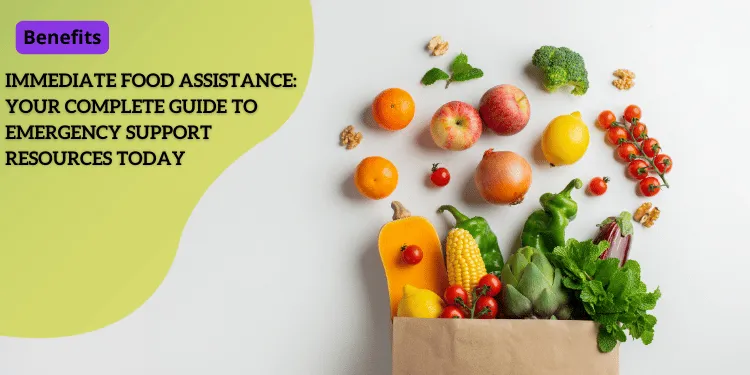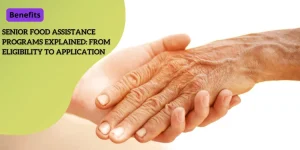Immediate Food Assistance: Your Complete Guide to Emergency Support Resources Today

Definition and Purpose of Emergency Food Support
Emergency food assistance is designed to provide quick relief to individuals and families facing food insecurity.
This support ensures that no one goes hungry while they work towards a more stable, long-term food security plan.
Typically, emergency food assistance includes non-perishable food items, ready-to-eat meals, and occasionally fresh produce.
The primary goal is to address immediate hunger needs and offer a safety net for those in crisis, promoting stability and a sense of security.
Types of Immediate Food Assistance Available
There are various types of immediate food assistance available to those in need.
These include:
- Food Pantries: Distributing non-perishable and sometimes perishable food items to individuals and families.
- Soup Kitchens: Providing hot, ready-to-eat meals on-site, often on a daily basis.
- Food Banks: Large warehouses that distribute food to local pantries, shelters, and meal programs.
- Emergency Food Boxes: Pre-assembled boxes containing essential groceries for immediate use.
- Meal Delivery Services: Especially beneficial for seniors or individuals with disabilities, ensuring they receive nutritious meals without leaving their homes.
Why Quick Access to Food Resources is Crucial
Quick access to food resources is vital for several compelling reasons.
Firstly, it addresses the immediate need to alleviate hunger, which can have severe implications on cognitive and physical health, making daily tasks challenging.
Secondly, having a reliable source of food fosters a sense of security and stability, which is crucial for mental well-being.
Additionally, emergency food support often acts as a gateway to other valuable services such as social networks and financial counseling, aiding in the journey towards long-term stability and independence.
Immediate food assistance is not just about providing meals; it is about creating a lifeline that supports individuals in their most vulnerable moments.
By ensuring quick and easy access to food, emergency food support plays an essential role in building a foundation for future stability and well-being.
Accessing Emergency Hotlines
When hunger strikes unexpectedly, having access to emergency hotlines can be a lifeline.
Knowing who to call can connect you to crucial food assistance resources quickly and efficiently.
Let’s explore some of the essential hotlines available.
211 Service for Local Food Assistance Connections
The 211 service is a nationwide hotline that connects callers to a variety of local services, including food assistance.
By dialing 211, you can get linked to local agencies, food banks, hot meal programs, shelters, and other organizations that cater to immediate needs.
This service is invaluable, especially in a crisis, because it offers:
- Quick connection to local resources
- Information on nearby food banks and distribution centers
- Guidance on navigating community services
USDA National Hunger Hotline (1-866-3-HUNGRY)
For people facing food insecurity, the USDA National Hunger Hotline provides another crucial resource.
By calling 1-866-3-HUNGRY (1-866-348-6479), available Monday through Friday, from 7:00 AM to 10:00 PM Eastern Time, you can receive:
- Referrals to local food assistance programs
- Information about meal sites and food pantries
- Support from knowledgeable operators who can guide you through the process
Spanish Language Support through 1-877-8-HAMBRE
Recognizing that language should never be a barrier to accessing food, the USDA National Hunger Hotline offers assistance for Spanish-speaking individuals through 1-877-8-HAMBRE (1-877-842-6273).
This service operates during the same hours as the main hotline and ensures that Spanish-speaking callers receive:
- Referrals to local food programs
- Information about meal sites and food pantries
- Support in navigating available resources
Accessing these emergency hotlines can make an immediate difference, ensuring that you and your family are connected to the necessary food support systems.
With these resources in place, there’s always a way to find help when it’s needed the most.
Next, let’s dive into how you can effortlessly locate nearby food banks and pantries to further support your immediate food needs.
Locating Food Banks and Pantries
Using Online Zip Code Locator Tools
Finding local food pantries has never been easier, thanks to online zip code locators.
Websites like FeedingAmerica.org allow you to enter your zip code and instantly receive a list of nearby food pantries.
This tool is user-friendly and provides quick results, ensuring you get the help you need without delay.
It often includes the locations, hours of operation, and contact information, making it easier to plan your visit.
Identifying Nearby Food Banks
Food banks are crucial in providing emergency food support, and identifying one near you can significantly impact those in need.
Start by visiting food banks’ websites or utilizing their hotlines.
Many food banks feature a search function on their websites where you can enter your zip code to find a partner agency or distribution center nearby.
This approach helps you quickly determine which food banks can serve your immediate needs.
Navigating Community Food Distribution Events
Community food distribution centers are another valuable resource.
These centers often collaborate with local government and non-profits to extend their reach to those in need.
You can find information about these centers by checking community bulletin boards, local news websites, or social media groups.
Additionally, reaching out to your town or city hall can provide up-to-date information on community resources and upcoming food distribution events.
By utilizing online tools, identifying nearby food banks, and accessing community distribution centers, you can secure emergency food support swiftly and efficiently.
Taking these steps will empower you to find the necessary resources, reducing the stress of food insecurity.
Religious and Community Support
Food Assistance Through Local Religious Institutions
Many local religious institutions, such as churches, mosques, and synagogues, play a pivotal role in offering food assistance to those in need.
Recognizing the importance of community support, these organizations often have food pantries or meal programs.
Typical offerings might include:
- Weekly or monthly food distributions
- Soup kitchens providing hot meals
- Holiday-specific food drives and meal services
To find such support, contact local religious institutions directly or visit their websites.
Many are well-connected to broader food assistance networks and can guide you to additional resources.
Community Organization Food Programs and Services
Beyond religious institutions, numerous community organizations are dedicated to providing emergency food services.
Non-profit organizations and local community centers often operate food programs designed to assist during crises.
These can include:
- Community food pantries: Distributing non-perishable food items regularly
- Meal delivery services: Especially for seniors or individuals with disabilities
- Community meals: Events where meals are shared, fostering support and camaraderie
To locate these services, consider reaching out to your local community center or checking if nearby non-profits have food assistance initiatives.
Websites like Feeding America also offer locator tools to find nearby resources.
Accessing Faith-Based Food Support Networks
Faith-based organizations significantly contribute to emergency food support through structured food programs often embedded within their charitable missions.
These programs might include:
- Faith-based food banks: Larger operations pooling resources from various congregations
- Emergency food boxes: Pre-assembled boxes containing essential groceries for immediate use
- Partnerships with local farms or food producers: Providing fresh produce to those in need
These programs can be navigated by visiting the organization’s website or contacting them directly.
Many faith-based organizations also collaborate with other local services to form a comprehensive support network, ensuring broader community coverage.
Next, let’s explore the documentation you’ll need to access these food support services and how to plan for long-term food security.
Documentation and Long-term Solutions
Required Documentation for Accessing Food Support
Before you head to a food pantry or other food support program, it’s important to gather the necessary documents to streamline the process.
These documents help verify your eligibility and ensure you receive assistance without unnecessary delays.
Typical documents include:
- Proof of Identity: ID card, driver’s license, or passport
- Proof of Residence: Utility bill, lease agreement, or mail addressed to you
- Income Verification: Recent pay stubs, a letter from an employer, or documentation showing unemployment benefits
Having these documents ready can help make your experience smoother and faster, allowing you to quickly receive the food support you need.
Applying for Long-term Assistance Programs
While immediate food assistance is crucial, it’s equally important to think about your long-term food security.
Programs like Supplemental Nutrition Assistance Program (SNAP) and Women, Infants, and Children (WIC) provide ongoing support to ensure consistent access to nutritious food.
Here’s a brief overview of these programs:
- Supplemental Nutrition Assistance Program (SNAP): Offers monthly food benefits to eligible low-income individuals and families. Applying for SNAP involves filling out an application, providing the required documentation, and sometimes attending an interview. SNAP benefits are distributed through an Electronic Benefits Transfer (EBT) card, which you can use to purchase groceries.
- Women, Infants, and Children (WIC): Aimed at helping pregnant women, new mothers, and young children with nutritional needs. WIC provides benefits for purchasing specific nutritious foods, along with nutrition education and health referrals. To apply, you’ll need to provide proof of identity, residence, and income, as well as medical forms attesting to the nutritional needs of the applicants.
Creating a Sustainable Food Security Plan
Developing a long-term food security plan is essential for ensuring ongoing access to nutritious meals.
Here are some steps to create a sustainable plan:
- Assess Your Needs and Resources: Start by evaluating your family’s nutritional needs and your available resources. Consider your income, community support, and any government assistance programs you may qualify for.
- Budget Wisely: Plan your meals and create a budget that prioritizes nutritious food. Use resources like couponing, discount groceries, and community farms to maximize your food budget.
- Utilize Local Resources: Take advantage of local food pantries, community gardens, and meal programs. Joining community-supported agriculture (CSA) programs can provide fresh produce at lower costs.
- Grow Your Own Food: If possible, start a small garden to grow your own vegetables and herbs. This can supplement your food supply and offer healthier options.
- Stay Informed and Connected: Keep abreast of new food assistance programs and community resources. Stay connected with local food networks, attend community meetings, and build relationships with support organizations.
By considering these steps, you can create a comprehensive plan that not only addresses your immediate food needs but also sets a foundation for long-term food security.





